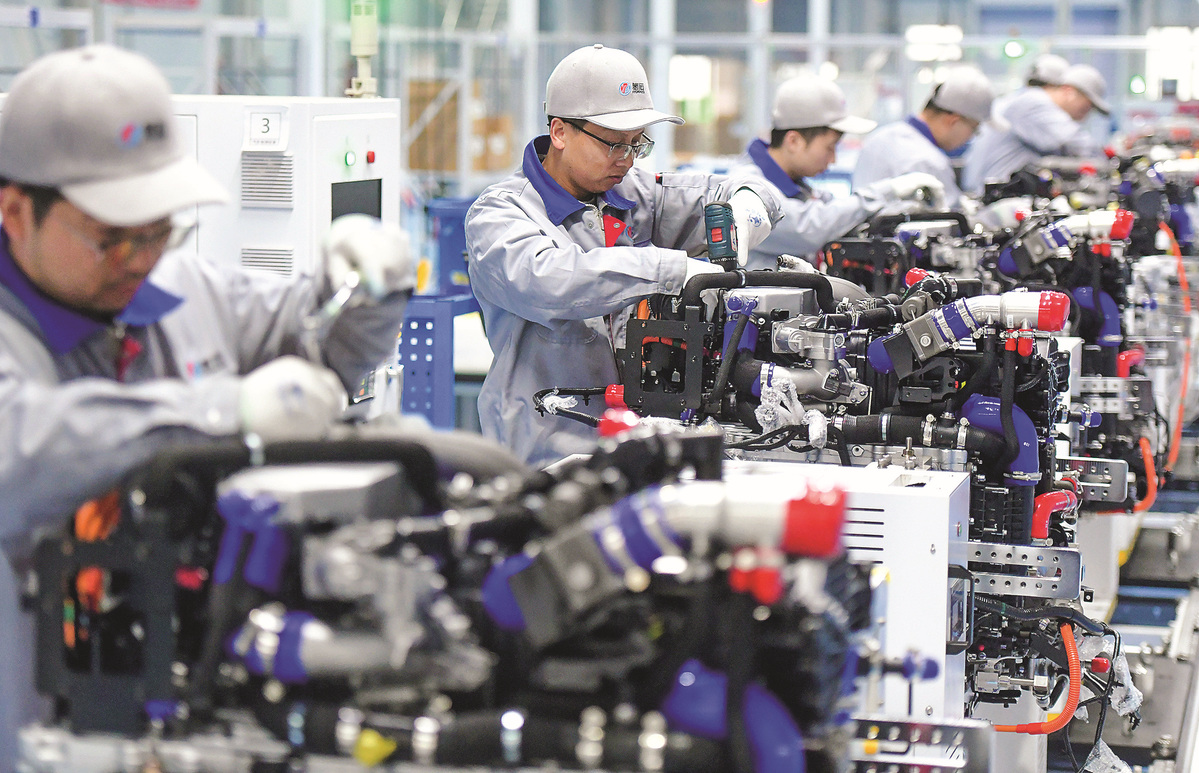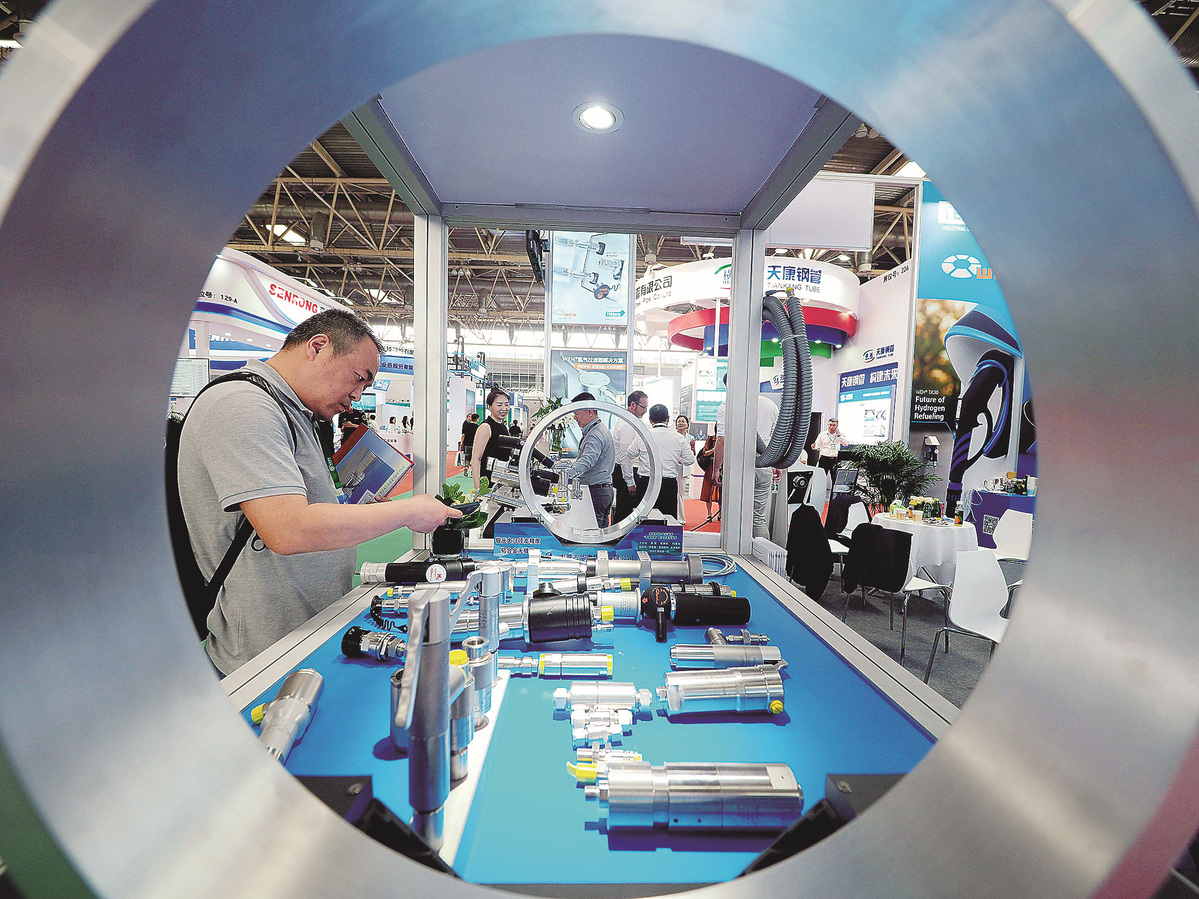
Workers assemble hydrogen fuel cell engines on a production line in Luoyang, Henan province in November. ZHANG YIXI/FOR CHINA DAILY
As China positions itself as a global leader in the production and utilization of green hydrogen, industry experts project a transformative leap in the nation's hydrogen sector, driven by declining costs, policy support and technological innovation.
Expanding the application of green hydrogen will be crucial for China to achieve deep cuts in carbon emissions while ensuring domestic energy security, as hydrogen not only provides a clean, emission-free energy source, but also offers valuable energy storage capabilities, they said.
Global consultancy Rystad Energy expects the share of green hydrogen in China to continue growing in the years to come, especially since it is installing new electrolyzer capacity at a world-leading pace every year, with similar trajectories seen in the solar PV and wind industries, which China continues to lead, it said.
Green hydrogen, produced using renewable energy, will dominate China's hydrogen supply in the coming decades, accounting for 90 percent by 2060 from the current negligible 0.2 percent of total production, said Liu Shiyu, vice-president of the China Electric Power Planning and Engineering Institute.
China, already the world's largest producer and consumer of hydrogen, accounted for over one-third of global output in 2023, with production reaching 35 million metric tons and expected to nearly triple to 100 million tons by mid-century, said Liu.
However, 80 percent is derived from fossil fuels, while the remaining 20 percent comes from industrial byproducts, making green hydrogen production still in its infancy, with just 60,000 tons produced annually as of 2023, he said.
Hydrogen in China is mainly produced from fossil fuels without using carbon capture, utilization and storage technology, ending up with massive carbon emissions during the process known as "gray hydrogen". "Blue hydrogen" has its carbon emissions captured and stored, or reused.
Despite this modest starting point, China's green hydrogen sector holds immense growth potential, said Liu, predicting it could become a flagship export sector in the years to come, rivaling the nation's globally recognized innovations in electric vehicles, solar panels and battery storage.
China, being the world's largest producer and consumer of hydrogen, holds significant strategic importance in fostering the development of sustainable green hydrogen, said Guo Liejin, a professor at Xi'an Jiaotong University.
Guo believes that more efficient, low-cost and large-scale green hydrogen and electricity co-production is imperative.

An attendee views a hydrogen refueling nozzle at an expo in Beijing in May. DU JIANPO/FOR CHINA DAILY
The process of producing hydrogen from renewable energy resources and using it as a carrier for energy storage, which can later be converted back to electricity, is considered a pivotal option for deep decarbonization at the terminal end, and has been gaining more international attention for its potential as an emissions-free fuel.
With China identifying hydrogen as a key element in its low-carbon energy transition strategy, Rystad Energy projects the installation of approximately 2.5 gigawatts of hydrogen electrolyzer capacity by the end of the year. This capacity is expected to produce 220,000 tons per annum of green hydrogen, 6 kilotons per annum more than the rest of the world combined, it said.
According to the institute, green hydrogen costs have already halved over the past five years, dropping to 22 yuan ($3) per kilogram in 2024 from 42 yuan per kg in 2019.
The institute forecasts further reductions, with production costs expected to fall below 20 yuan per kg by 2025 and 15 yuan per kg by 2030, thanks to the scaling up of wind and solar power generation, as well as technological advancements such as improvements in electrolyzer efficiency.
By 2060, green hydrogen is projected to cost less than its carbon-intensive counterpart, gray hydrogen, which currently averages around 10 yuan per kg. The cost parity between green and gray hydrogen is expected to unlock new commercial opportunities, paving the way for hydrogen to compete purely on economic merit rather than environmental credentials, said a report on China's hydrogen industry development released by the institute.
Recognizing the sector's strategic importance, Chinese provincial-level regions are rolling out tailored policies to boost hydrogen production, transport, storage and application.
Regions with strong solar and wind potential, especially those in Northwest China, have announced more ambitious hydrogen production targets.
The Inner Mongolia autonomous region aims for 480,000 tpa of renewable hydrogen production by 2025, while Gansu province has set a target of 200,000 tpa, all of which are expected to contribute enormously to China's hydrogen production in the region.
China's coal-rich regions are also transforming their energy landscapes by investing in hydrogen. Xiaoyi, Shanxi province, historically dependent on coal mining, has been investing in hydrogen technology and infrastructure, including building hydrogen production plants, refueling stations and research facilities, harnessing its industrial expertise and infrastructure.
Guo Qingzhi, mayor of Xiaoyi, believes that the hydrogen energy industry, as a representative of new quality productive forces in the energy sector, has strong momentum and promising prospects.
Rystad Energy said, geographical disparity exists between China's hydrogen demand centers in the east and its abundant solar and wind energy resources in the north, which are ripe for developing green hydrogen production.
This has resulted in a supply-demand mismatch, prompting China to explore the expansion of its network of hydrogen pipelines, it said.

A hydrogen truck fills up at an H2 refueling station of CNPC at Chongqing International Logistics Hub Park in June. SUN KAIFANG/FOR CHINA DAILY
To support this rapid expansion, a robust hydrogen transportation network is in the works. By 2060, China aims to establish a system capable of transporting 30 million tons of hydrogen annually, approximately one-third of the nation's projected production.
This network is set to become a cornerstone of China's energy infrastructure, enabling seamless integration of hydrogen into the broader energy mix.
China Petroleum & Chemical Corp launched a project last year to channel hydrogen from Inner Mongolia to Beijing this year through a 400-kilometer hydrogen pipeline, the country's first trans-regional, long-distance channel.
This pipeline will be able to handle about 100,000 tons of hydrogen annually when its first phase is completed, and has the potential to increase capacity by 500,000 tons over the long run, it said.
The company estimates that China's hydrogen energy consumption is projected to reach nearly 86 million tons by 2060, with an industry scale of 4.6 trillion yuan.
Tangshan Haitai New Energy Technology, a unit of Chinese solar company Haitai Solar, is currently constructing a 737-km hydrogen pipeline, the world's longest, paving the way for future exports of renewable hydrogen.
The Zhangjiakou Kangbao-Caofeidian pipeline, named after its origin and destination points, is estimated to cost 6.1 billion yuan and is expected to be completed by June 2027.
The introduction of China's first energy law, which is to fully take effect on Jan 1, 2025 and fortify the legal framework within the energy sector, marks a turning point for the hydrogen industry, said Du Xiangwan, an academician at the Chinese Academy of Engineering, emphasizing the law's pivotal role in providing legal backing for hydrogen's planning, development and emergency reserves.
"The energy law has removed hydrogen from the regulatory framework of hazardous chemicals, addressing a long-standing bottleneck," Du said.
The energy law explicitly prioritizes the orderly advancement of hydrogen energy, signaling strong government commitment to the sector.
"It offers clarity and confidence for industry stakeholders, while laying the foundation for high-quality development," Du added.
BloombergNEF predicts that China will emerge as a key market for hydrogen, with hydrogen fuel cell vehicles set for significant growth as the country pursues its dual carbon goals, reaching peak carbon emissions before 2030 and achieving carbon neutrality before 2060.
China, along with Europe and the United States, are expected to account for more than 80 percent of global clean hydrogen supply by the end of the decade, driven by favorable policies and a robust pipeline of advanced projects, it said.
Source: By Zheng Xin, chinadaily.com, Dec 10, 2024 [https://www.chinadaily.com.cn/a/202412/10/WS67579f9aa310f1265a1d20a1_1.html]

